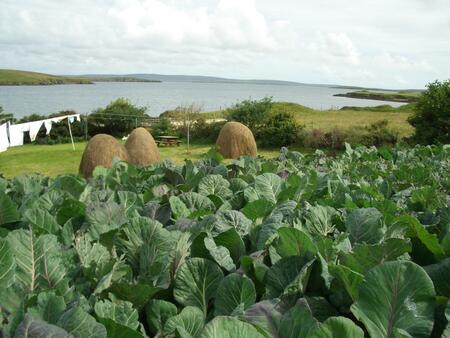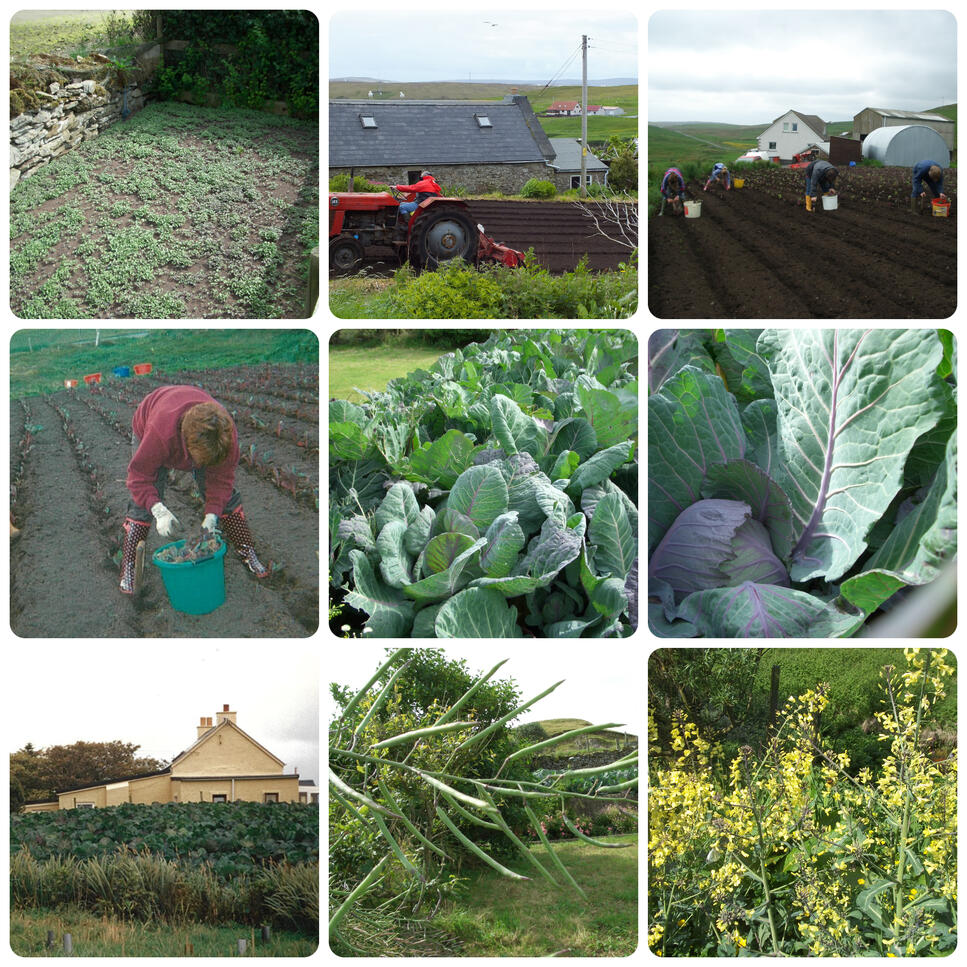Kathleen Anderson tells her story of growing up on a South Collafirth croft in the 1950s and 1960s.
Being brought up on the South Collafirth croft in the late 1950s and 1960s, we grew kale, neeps, tatties and corn – as did all the crofts at that time – to feed kye and sheep through the winter. Crofters with kye had dir own milk/ butter, kirn milk and blaand.
In the voar time, the seed stocks would have been set first. Then the yard would have been mucked, ploughed, harrowed and furred, before the kale plants were set in April – if possible – then hoed twice at 2 – 3 week intervals, before being heaped. The garden was delled and the early tatties set.
This was followed by the main crop. Everyone had a bucket with seed tatties and spaced them in the furrow behind the tractor and plough. This tattie rig would have been hoed twice, then heaped which was exciting as we borrowed a horse from Barnafield to heap with it.

Corn rigs were ploughed, harrowed, sown and harrowed again, then when it had sprung it was rolled.
In May, peats were ‘casted’ – 4 people worked for a day to get enough peats for a year’s burning. After 2/3 weeks they were raised, followed by another 2/3 weeks when they were turned, then brought home at the end of August.
In June, Plantie crubs were delled and sown. With the hill sheep – lambs were marked, gimmers and yield sheep clipped.
The neeps weren’t sown until after the 13th June (to try to avoid the worm). Two kinds of neeps were sown: Tankards (a big, long neep for animal feed – also good for neepie lanterns) and swedes – for feeding and also used for cooking. The neeps were hoed, singled, and then hoed again.
Towards the end of July, the rye grass was mown. I mind my father and uncle mowing with sythes wearing their white canvas caps and singlets.
The summer months were otherwise taken up with curing hay, ‘wherving’, coling, and then dessing – a job which neighbours helped each other with. I remember the weather seeming really good, as were the raspberries that grew below the plantie crub.
In September, corn was usually cut with a sythe and gathered into sheaves, but a binder did come around on some years. They were set into sixes, stooked then hirdid, and built into skroos (stacks) in the yard along with the desses of hay.
In October, the kye were given kale blades gathered daily for them and the neep shaws were cut off and fed to them. Towards the end of October and into November, wir folk riped the tatties just by digging them up by hand. In the same month, we bedded the neeps.
The winter months were spent feeding rye grass to kye in the morning, kale in the middle of the day and sheaves of corn at night – when the coo would have been milked. Kale was taken to the house and cut at night for feeding the lambs at the lambhouse the next morning. They had hay and water at night.

Changes to the crofting way of life
This continued until the late 1970’s and early 1980’s when silage started to be made. Findlin’s Farm started a dairy and delivered milk, meaning there wasn’t the same need for a house coo.
As time went on the sythe was replaced by finger mowers, making hay and corn cutting a bit easier. Tatties were set with a planter and lifted with a spinner. Again, neighbours got together to gather the tatties going from one croft to another. As bairns, we were very fortunate that most of our neighbours were relations, and the ones who weren’t still treated us as if we had been.
The last rigs o’ corn to be cut and made into sheaves was in 1981. After that any corn sown would have been made into silage. When silage was made, it changed crofting. Bigger fields were needed for the bigger machinery. The kale yards were still wrought, but we didn’t have tattie rigs anymore. So that ended the hay making and the other types of work which people gathered together to do.
I look back with fond memories of a way of life almost entirely gone. However, I still grow Shetland kale – just 3 small yards (roughly about 2000 plants) and feed it to my kye, sheep, and hens. We also eat it in our house and give it to neighbours – normally to eat it with tattie soup – and I can never resist eating a piece of shank when I’m cutting a stock!
Kathleen Anderson, 2022
